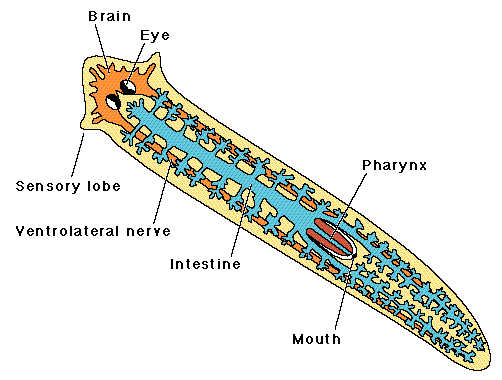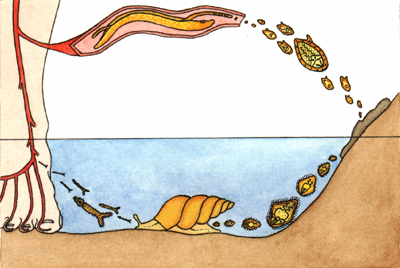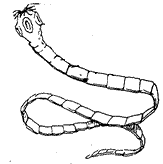FLATWORMS

Kingdom Animalia, Phylum Platyhelminthes (Flatworms)
Three embryonic germ layers
Bilateral symmetry
Cephalization (head)
Coelom (Greek for cavity or hollow) = a fluid filled body cavity
Acoelomates = without coelom
Form and Function in Flatworms
Feeding:
Free-living = carnivores or scavengers
Have digestive cavity, mouth, pharynx
Parasites: = Feed on blood, tissue fluids, or pieces of cells from within a host
Most do not have a complete digestive system because they absorb digested material directly
Respiration, Circulation, and Excretion:
Thin bodies allow for materials to diffuse (resp, excrection..etc)
Flame cell = specialized cells that remove excess water
Response:
Ganglia = group of nerve cells control the nervous system (like a brain)
Eyespot = group of cells that can detect light
Movement:
Flatworms moves in
2 ways
1) Cilia = helps them glide through water and on stream floors
2) Muscle cells = twist and turn
Reproduction:
Sexual Reproduction
= Hermaphrodites = has both male and female reproductive organs
Asexual Reproduction by fission = organism spits in two
GROUPS OF FLATWORMS
 1. Class Turbellarians = free-living flatworms
1. Class Turbellarians = free-living flatworms
Fresh or marine water
Example: Planarians (cross-eyed)
Planarian(also known as Dugesia)--lives in freshwater
--mostly a scavenger, also feeds on protists
--hermaphrodites
--they can regenerate (regrow parts), Reproduction by FISSION
Anatomy of the Planarian
Brain (ganglia) -
planarian can process information about their environement
Pharynx - used for suckling food in (the mouth is at the end of the pharynx)
Eyespot - simple eye, can detect light
Flame cells - located along the lateral edges, used for excretion
Intestine - digestion (does not have an anus)

Investigation: Planaria and Regeneration
2. Class Trematoda
= parasitic flatworms
a.k.a "flukes" live in mouth, skin, or gills of host
Primary host = the
host in which a parasite reproduces sexually
Intermediate host = the host in which asexual reproduction occurs
Schistosoma mansoni
- multiple host:
Primary host = human
Intermediate host = snail
Causes Schistosomiasis -in humans; decays lungs liver, spleen, or intestines. Tropical areas with poor sanitation/sewage.

3.
Class Cestoda =tapeworms
Long, flat, parasitic
Live in intestines

Scolex = a structure
that contains suckers and/or hooks
Proglottids = body segments of the tapeworm
Each mature proglottid is a hermaphrodite
Testes produce sperm, fertilize the eggs to produce a zygote
Zygotes are passed out through the feces.
A dormant, protective cyst is formed in the intermediate cyst.
This is why you should never eat incompletely cooked meat.
